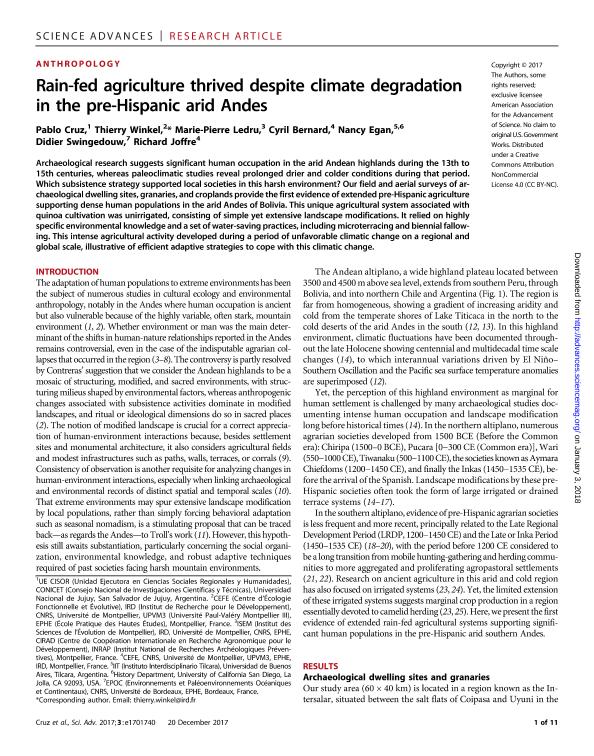Artículo
Rain-fed agriculture thrived despite climate degradation in the pre-Hispanic arid Andes
Cruz, Pablo ; Winkel, Thierry; Ledru, Marie Pierre; Bernard, Cyril; Egan, Nancy; Swingedouw, Didier; Joffre, Richard
; Winkel, Thierry; Ledru, Marie Pierre; Bernard, Cyril; Egan, Nancy; Swingedouw, Didier; Joffre, Richard
 ; Winkel, Thierry; Ledru, Marie Pierre; Bernard, Cyril; Egan, Nancy; Swingedouw, Didier; Joffre, Richard
; Winkel, Thierry; Ledru, Marie Pierre; Bernard, Cyril; Egan, Nancy; Swingedouw, Didier; Joffre, Richard
Fecha de publicación:
20/12/2017
Editorial:
American Association for the Advancement of Science
Revista:
Science Advances
ISSN:
2375-2548
Idioma:
Inglés
Tipo de recurso:
Artículo publicado
Clasificación temática:
Resumen
Archaeological research suggests significant human occupation in the arid Andean highlands during the 13th to 15th centuries, whereas paleoclimatic studies reveal prolonged drier and colder conditions during that period. Which subsistence strategy supported local societies in this harsh environment? Our field and aerial surveys of archaeological dwelling sites, granaries, and croplands provide the first evidence of extended pre-Hispanic agriculture supporting dense human populations in the arid Andes of Bolivia. This unique agricultural system associated with quinoa cultivation was unirrigated, consisting of simple yet extensive landscape modifications. It relied on highly specific environmental knowledge and a set of water-saving practices, including microterracing and biennial fallowing. This intense agricultural activity developed during a period of unfavorable climatic change on a regional and global scale, illustrative of efficient adaptive strategies to cope with this climatic change.
Archivos asociados
Licencia
Identificadores
Colecciones
Articulos(UE-CISOR)
Articulos de UNIDAD EJECUTORA EN CIENCIAS SOCIALES REGIONALES Y HUMANIDADES
Articulos de UNIDAD EJECUTORA EN CIENCIAS SOCIALES REGIONALES Y HUMANIDADES
Citación
Cruz, Pablo; Winkel, Thierry; Ledru, Marie Pierre; Bernard, Cyril; Egan, Nancy; et al.; Rain-fed agriculture thrived despite climate degradation in the pre-Hispanic arid Andes; American Association for the Advancement of Science; Science Advances; 3; 12; 20-12-2017; 1-11; e1701740
Compartir
Altmétricas



